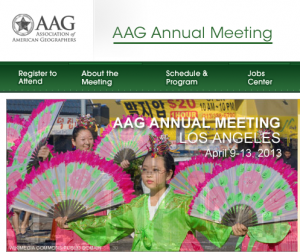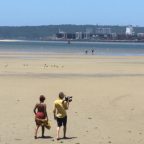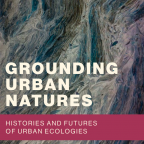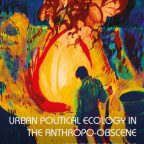
Our project Ways of Knowing Urban Ecologies had several presentations and sessions at AAG 2103.
The AAG 2013 was a great conference. Huge as always—we heard that some 7000 geographers were walking around in the big downtown LA hotels were the conference was held in April this year.
In our research team on the ‘Ways of Knowing Urban Ecologies’ we had a great presence.
We had in total 5 paper presentations, organized one special session and were invited to two different panels. The following summarizes our efforts:
1. Mary Lawhon presented a theoretical paper on “Provincializing Urban Political Ecology—Towards a Situated UPE through African Urbanism” that is co-authored by Henrik Ernstson and John Silver.
2. Marnie Graham presented on her case study on Macassar Dunes in Cape Town.
3. Joshua Lewis presented on his study in New Orleans in a special session on New Orleans post-Katrina.
4 Jane Battersby presented on her great work at the Philippi Horticulture Area in Cape Town.
5. Henrik Ernstson presented on a first synthesis paper of the four case studies we have been working on in Cape Town—Cecilia Forrest (with Jessica Rattle), Bottom Road & Princess Vlei (Henrik Ernstson), Philippi Horticulture Area (Jane Battersby), and Macassar Dunes (Marnie Graham).
Apart from this:
6. Jane Battersby and Henrik Ernstson organised a special session covering two slots on “Articulating Values in Urban Green Spaces” with great presentations from different scholars and research teams and with case studies from North America, Europe and Africa.
7. Mary Lawhon and Henrik Ernstson were invited as panelists, together with Garth Myers, to round off a great full day or “Postcolonial Urbanisms”.
8. Henrik Ernstson was also invited as panelist on the first days session on “Environmental Governance & Ecosystem Services”.
We also had several of our colleagues at ACC that was presenting: With Edgar Pieterse making great talks that were really talked about, and Anna Taylor on her work from Cape Town. More information on our abstracts and special sessions follow below:
WOK-UE presentation abstracts
Mapping and counter-mapping: Asserting values in the Philippi Horticultural Area, Cape Town, South Africa
Jane Battersby, Dr – University of Cape Town
Abstract: The Philippi Horticultural Area, a 2600ha agricultural area within the City of Cape Town, is a highly contested space. The City currently has a housing backlog of some 400 000 dwelling units, and it has been argued by developers and the City’s housing department that this land should be given over for housing and other urban uses. This view is supported by some of the farmers and other Provincial and City government departments. There are, however, other departments and groups of farmers who wish to protect the area for agriculture. Debates about the future of the Philippi Horticultural Area have been played out through a series of meetings and reports depending on maps to make truth claims about the Area. This paper presents an analysis of the ways in which values and ideological framings are presented and reinforced through these supposedly neutral mapping exercises. The paper therefore engages the power bases of these multiple ways of knowing that exist in a single site and the connections and dissonances between different actors through the reading of these practices of mapping. Was part of the Paper Session: Articulating Value in Urban Green Space
(Re)Negotiating Nature on the Geographic Urban Fringe
Bracing Achilles’ Heel: The Retrofitting and Transformation of New Orleans’ Inner Harbor Complex
Provincialising Urban Political Ecology: Expanding UPE through African Urbanism
Henrik Ernstson – Stockholm University & University of Cape Town
Suraya Fazel-Ellahi – University of Manchester
Jonathan Silver – Durham UniversityAbstract: Urban political ecology has provided a critical lens on the sociomaterial construction of urban environments and contestation over power and urban resources. We review the broad field of political ecology, including studies in the global North and South, urban and rural, and using Marxist/structuralist and post-colonial/poststructural theory. We suggest UPE typically begins with a structural theory of power, then examines particular artefacts to provide a critique of society. Using theoretical and empirical work from African urbanism, we begin suggesting what a provincialized, expanded UPE might entail: starting with the everyday, examining diffuse power, and opening the scope for radical incrementalism. Such insights from African cities are one means through which to expand UPE. Rooting research in a broader definition of political ecology which includes post-structuralist and post-colonial theory and starts from theory and empirics in cities of the South can provide new theory
Reworking urban natures through empirical case studies in Cape Town: Contestations through alien trees, indigenous shrubs, wetlands and vegetables
Jane Battersby, PhD – African Centre for Cities, University of Cape Town
Marnie Graham – Department of Systems Ecology, Stockholm University
Mary Lawhon, PhD – African Centre for Cities, University of Cape Town
Joshua Lewis – Department of Systems Ecology, Stockholm University
Jessica Rattle – African Centre for Cities, University of Cape Town
Sverker Sörlin, Professor – Environmental Humanities Lab, Royal Institute of Technology (KTH) StockholmAbstract: Formed by apartheid planning and contemporary struggles over land and livelihoods, Capetonian urban natures are also reworked through global discourses of environmental knowing like sustainability, resilience, biodiversity, ecosystem services, and food security. These global concepts have ‘landed’ in contemporary contestations over land to legitimize certain demands and ways of knowing, while silencing others. With competing theories and perspectives on urban nature, this paper argues for the need of close empirical studies from different world regions to contribute to theoretical debates on how urban natures are reworked in-place. We report on comparative findings from four case studies in Cape Town: (i) contestation between conservation managers and citizens in a wealthy suburb around “alien” trees; (ii) how marginalized groups from an apartheid township have used wetlands and ecological rehabilitation to mobilize environmental protection and articulate memories of oppression; (iii) how land for urban farming have been situated between food security and housing developments; (iv) and the contested understandings of ‘co-management’ at a nature reserve bordering slum dwellings. Departing from postcolonial and comparative urbanism (Robinson, McFarlane), we unpack the multiple meanings of urban nature, and the actors and discourses involved. The comparison demonstrates the variability of locally crafted ways of knowing urban natures that are performed through socio-historically specific processes. We also note how the case studies allows for examination of how global ways of environmental knowing enters local debates and are negotiated through local practices. The studies are part of a project including studies in New Orleans and Stockholm. Was part of the Paper Session: Reworking Urban Nature: Tensions and Synergies in the Greening of Cities I
Panel and Paper Sessions organized by WOK-UE or in which members from WOK-UE participated in:
5429 Post-colonial Urbanisms: African connections and innovations III: A Discussion
Sponsorship(s): Africa Specialty Group, Political Geography Specialty Group, Urban Geography Specialty Group
Paper Session:
1608 Articulating Value in Urban Green Space 2
Tuesday, 4/9/2013, from 4:40 PM – 6:20 PM in San Bernardino, Westin, Lobby Level
Organizer(s): Jane Battersby – University of Cape Town; Henrik Ernstson – African Centre for Cities, University of Cape Town
Chair(s): Henrik Ernstson – African Centre for Cities, University of Cape Town
Session Description: The use and management of urban green space is a site of contestation between actor groups in many cities. At the heart of these contestations, and as entry points for analysis, are often differing articulations of the value of these sites. However, the skills, tools, expertise and discursive strategies necessary to articulate what is of value are unevenly distributed, which influences decisions regarding use and management, and the (bio)physical shaping of the urban landscape. This session gathers papers which focus on detailed case studies on the ways in which meaning, identity and value is created in and through urban green space, with the intention of developing a discussion on how and why particular articulations have political resonance. The session aims to provoke a discussion of how such empirical accounts—when brought together—can work to challenge the many academic and policy-driven normative projects on ‘what to do with the urban’ related to calls for sustainability and resiliency. The papers represent a range of theoretical perspectives, such as political ecology, cultural geography, urban ecology, cultural studies, critical urban theory, urban geography, planning, and social movement studies, and purposefully includes papers with empirical material from the global south and the global north.
2.40 PM Author(s): Alice Oldfield* – University of St Andrews
Title: Recollection. Nostalgia and the value of a community park: a comparative case study from Leeds, England
Abstract: Public parks are longstanding features of urban neighbourhoods in the UK. While widely acknowledged as valuable community facilities, discussions of these arenas frequently tie their importance to aspects of their use, with emphasis commonly placed on the benefits of recreation in these spaces. Local parks, however, also constitute part of the residential environment and their value thus extends beyond these functional elements. While some attention has been paid to the broader importance of large-scale public parks, few have constructed detailed accounts of the value of more local spaces and the extent to which different forms of value apply at this smaller scale remains unclear. Drawing on a mixed-method comparative case study in Leeds, England, this paper highlights a temporal inconsistency in accounts of the value of community parks. Despite their durability, importance derived from past experience in these spaces has often been neglected and their symbolic value has been relatively underexplored. Engaging with a framework of value derived in landscape economics, this paper identifies both nostalgia and recollection value, stressing that a local park not only constitutes part of collective culture but also actively engages an individual’s memories. The paper stresses that these underexplored aspects constitute key facets of the value of these community green spaces, noting that these elements are likely to become only more significant with ageing populations across Europe and an emphasis on enabling people to ‘age in place’.



